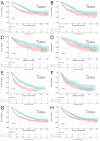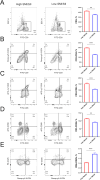Skeletal muscle index/systemic immune-inflammation index (SMI/SII) ratio predicts prognosis in patients with hepatocellular carcinoma
- PMID: 40320549
- PMCID: PMC12051346
- DOI: 10.1186/s12957-025-03826-x
Skeletal muscle index/systemic immune-inflammation index (SMI/SII) ratio predicts prognosis in patients with hepatocellular carcinoma
Abstract
Background: Systemic inflammation and skeletal muscle are associated with prognosis in hepatocellular carcinoma (HCC). The prognostic value of a combination of skeletal muscle index (SMI) and systemic immune-inflammation index (SII) remains unclear. The present study aims to investigate the prognostic value of combined SMI and SII in predicting overall survival (OS) for HCCs after liver resection (LR) or transarterial chemoembolization (TACE).
Methods: This multi-institutional study included three retrospective datasets and one prospective dataset. The SMI/SII was calculated for each cohort. The performance of SMI/SII in predicting recurrence after LR was evaluated in the training cohort, and the optimal cut-off value was calculated. Based on optimal cut-off value, patients were stratified into low and high SMI/SII groups. Cox regression analysis were performed to determine the independent prognostic factors for poor OS. In prospective validation-3 cohort, peripheral blood samples were analyzed for correlation between SMI/SII and distribution of immune cells.
Results: A total of 1504 patients were included. The AUC of SMI/SII was 0.701. The OS was significantly better in the high SMI/SII group than that in the low SMI/SII group in the training, validation-1, validation-2 cohorts, and combined those three cohorts. Furthermore, low SMI/SII level was an independent prognostic factor for poor OS. Additionally, findings in validation-3 cohort indicated that patients with HCCs and high SMI/SII display anti-tumor attributes in their peripheral blood composition.
Conclusion: A decreased SMI/SII may be a distinct biomarker of unfavorable prognosis in patients with HCCs, which may be practical to develop personalized treatment strategies for HCC.
Keywords: Hepatocellular carcinoma; Nutrition status; Prognosis; Systemic inflammation.
© 2025. The Author(s).
Conflict of interest statement
Declarations. Ethical approval: The study was approved by the institutional review boards of the Second Xiangya Hospital of Central South University, the Affiliated Cancer Hospital of Guizhou Medical University, the Hunan Cancer Hospital and the Affiliated Hospital of Guizhou Medical University. This study was conducted in accordance with the Helsinki Declaration. The requirement of written informed consent was obtained for the prospective dataset only, while it was waived for the retrospective datasets owing to the study design. Consent for publication: Not applicable. Competing interests: The authors declare no competing interests.
Figures




Similar articles
-
Prognostic value of preoperative systemic immune-inflammation index/albumin for patients with hepatocellular carcinoma undergoing curative resection.World J Gastroenterol. 2024 Dec 28;30(48):5130-5151. doi: 10.3748/wjg.v30.i48.5130. World J Gastroenterol. 2024. PMID: 39735268 Free PMC article.
-
Systemic immune-inflammation index predicts prognosis of patients after curative resection for hepatocellular carcinoma.Clin Cancer Res. 2014 Dec 1;20(23):6212-22. doi: 10.1158/1078-0432.CCR-14-0442. Epub 2014 Sep 30. Clin Cancer Res. 2014. PMID: 25271081
-
Rapidly declining skeletal muscle mass predicts poor prognosis of hepatocellular carcinoma treated with transcatheter intra-arterial therapies.BMC Cancer. 2018 Jul 24;18(1):756. doi: 10.1186/s12885-018-4673-2. BMC Cancer. 2018. PMID: 30041616 Free PMC article.
-
Prognostic model for predicting recurrence in hepatocellular carcinoma patients with high systemic immune-inflammation index based on machine learning in a multicenter study.Front Immunol. 2024 Sep 9;15:1459740. doi: 10.3389/fimmu.2024.1459740. eCollection 2024. Front Immunol. 2024. PMID: 39315112 Free PMC article.
-
Transarterial chemoembolization versus hepatic resection in hepatocellular carcinoma treatment: a meta-analysis.Drug Des Devel Ther. 2015 Aug 10;9:4431-40. doi: 10.2147/DDDT.S86629. eCollection 2015. Drug Des Devel Ther. 2015. PMID: 26309396 Free PMC article. Review.
References
-
- Calderaro J, Ziol M, Paradis V, et al. Molecular and histological correlations in liver cancer. J Hepatol. 2019;71:616–30. - PubMed
-
- Bao Y, Li JX, Zhou P, et al. Identifying proliferative hepatocellular carcinoma at pretreatment CT: implications for therapeutic outcomes after transarterial chemoembolization. Radiology. 2023;308:e230457. - PubMed
-
- Llovet JM, Kelley RK, Villanueva A, et al. Hepatocellular carcinoma. Nat Rev Dis Primers. 2021;7:1. - PubMed
-
- Feng ZC, Li HL, Liu QY, et al. CT radiomics to predict macrotrabecular-massive subtype and immune status in hepatocellular carcinoma. Radiology. 2023;307:e221291. - PubMed
-
- Yau T, Tang VYF, Yao TJ, et al. Development of Hong Kong liver cancer staging system with treatment stratification for patients with hepatocellular carcinoma. Gastroenterology. 2014;146:1691–700. - PubMed
Publication types
MeSH terms
Grants and funding
LinkOut - more resources
Full Text Sources
Medical
Miscellaneous

